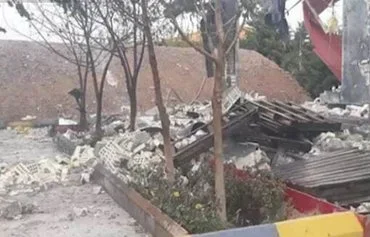Security
Deadly blasts expose hidden dangers of Iranian regime's dual-use sites
Recent explosions at a gunpowder factory and port missile fuel depot reveal the deadly cost of the regime's dual-use military-industrial system.

By Maryam Manzoori |
An explosion at a chemical warehouse in Isfahan province killed two people and injured two others on April 29, in the second major industrial disaster to strike the Islamic Republic in less than a week.
Iranian emergency services contained the blaze, but officials have provided no explanation for the explosion at Ava Nar Parsian Chemical Industries facility in Meymeh beyond vague references to safety lapses during firework production.
The facility produces fireworks and gunpowder. It has links to the regime's security and military establishment via its executive leadership and oversight structure, according to an Iran International investigation.
Company executive Damoun Beheshtnejad previously managed Nargostar Sepahan, a chemical facility in Isfahan that experienced a major explosion in 2021 and housed the country's drone manufacturing operations, it said.
Ava Nar Parsian operates under the supervision of the Supreme National Security Council and holds licenses for producing and trading various explosives.
Dual-use sites
The Meymeh blast came just days after a devastating explosion at the Shahid Rajaee port near Bandar Abbas killed at least 57 people and injured over 1,000.
The port explosion was linked to improperly handled sodium perchlorate rocket fuel, according to the Associated Press and a source close to the Islamic Revolutionary Guard Corps (IRGC) who spoke to the New York Times.
The cargo had been shipped from China to replenish the regime's missile stocks, the sources said, refuting official denials that military materials were present.
"The dual-use nature of these sites, serving both civilian and military purposes, raises serious concerns about the militarization of civilian infrastructure," said an industrial safety expert at a Karaj car factory, who gave his name as Ahmad.
"Ava Nar Parsian appears to produce colorful fireworks for public celebrations like the anniversary of the Islamic Revolution in Tehran and claims to prioritize safety," he told Pishtaz, withholding his last name out of concern for his safety.
"But they clearly failed to meet basic safety standards."
'A land of fires'
Innocent civilians are the "first victims" of the Iranian regime's "military and nuclear adventures," Tehran resident Mahsa, a mother of two, told Pishtaz.
"Every day we hear about explosions, fires, water shortages, blackouts, mismanagement and toxic air," she said.
"I am worried about my children's future."
"Over the past eight days, Iran has become a land of fires and massive explosions, with many citizens killed or injured," political analyst Ali Afshari wrote on X.
"The deepening crisis of incompetence, mismanagement, lack of safety and security, and accelerating decay of infrastructure and facilities has left the people defenseless and exposed to serious physical danger," he said.